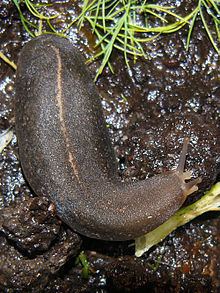Kingdom Animalia Family Veronicellidae Scientific name Laevicaulis alte Higher classification Laevicaulis | Superfamily Veronicelloidea Genus Laevicaulis Phylum Mollusca Rank Species | |
 | ||
Similar Laevicaulis, Veronicellidae, Veronicella, Systellommatophora, Sarasinula | ||
Tropical leatherleaf snail video
The tropical leatherleaf, scientific name Laevicaulis alte, is a species of tropical land slug, a terrestrial pulmonate gastropod mollusk in the family Veronicellidae, the leatherleaf slugs.
Contents
- Tropical leatherleaf snail video
- Tropical leatherleaf slugs
- Description
- Parasites
- Predators
- Distribution
- Habitat
- Feeding habits
- Life cycle
- References
Tropical leatherleaf slugs
Description
Laevicaulis alte is a round, dark-coloured slug with no shell, 7 or 8 cm long. Its skin is slightly tuberculated. The central keel is beige in colour.
This slug has a unique, very narrow foot; juvenile specimens have a foot 1 mm wide and adult specimens have a foot that is only 4 or 5 mm wide.
The tentacles are small, 2 or 3 mm long, and they are only rarely extended beyond the edge of the mantle.
Parasites
This slug is an intermediate host for Angiostrongylus cantonensis, the rat lungworm, a round worm, the most common cause of eosinophilic meningoencephalitis.
Predators
This slug is eaten by the frog Rana tigrina.
Distribution
This species is probably indigenous to Africa (western Africa and eastern Africa).
It has been introduced and become an invasive species in the following areas:
This species is already established in the USA, and is considered to represent a potentially serious threat as a pest, an invasive species which could negatively affect agriculture, natural ecosystems, human health or commerce. Therefore it has been suggested that this species be given top national quarantine significance in the USA.
Habitat
This species lives in dry areas, mostly at lower altitudes.
Feeding habits
What this slug eats in the wild is not known. In captivity this slug will eat:
In captivity it will not eat:
Life cycle
This slug hatches from eggs. This species has several adaptations for living in dry conditions: a rounded shape with as small as possible surface area, and a narrow foot to reduce evaporation.
Juvenile specimens search for food nearly always at night, and stay buried in the soil during the day. Larger specimens are active during the day sometimes. This slug can grow up from 0.5 cm to approximately 4 cm in length in 7 months.
